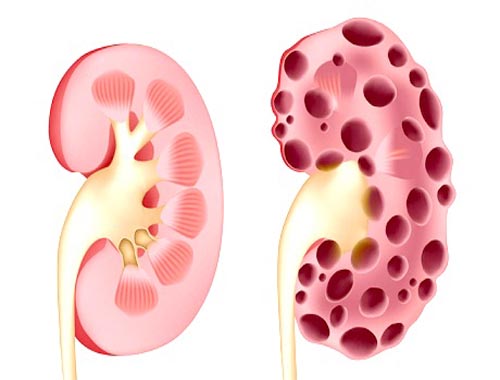Polycystic Kidney Disease
According to the American Kidney Foundation, polycystic kidney disease (PKD) is the most common life threatening genetic disorder caused by a single gene and affects between 1 in 400 to 1,000 people worldwide. It is characterized by fluid-filled cysts that form in the nephrons of both kidneys (bilateral) and eventually lead to kidney failure in the majority of patients. Polycystic kidney disease is the fourth most common cause of kidney failure. Cysts usually begin as an outpouching (like a blister) anywhere along the length of the nephrons. Approximately 70% of the cysts detach from the nephron when they are small and proceed to enlarge as they fill with either clear fluid or fluid that may contain blood cells. In patients with PKD, hundreds to thousands of cysts can develop that range from the size of a pinhead to as large as a grapefruit (10-20 cm.) in diameter. Each kidney may expand to as large as a football and may weigh up to 38 pounds. The continual enlargement of cysts crowds out healthy kidney tissue. The kidneys may quadruple in size before kidney function is affected at which point renal function rapidly declines. In addition, normal tissue can be actively destroyed and fibrous tissue can form resulting in a condition called interstitial fibrosis. The combination of cysts and progressive interstitial fibrosis is thought to accelerate chronic renal failure, resulting in the kidney's loss of ability to cleanse the blood and concentrate urine. There are at least three factors related to cyst formation in the kidney but exactly what triggers the process is unclear. These three factors include: Increased production of cells lining the cyst wall. These cells continue to reproduce throughout life and enable the cyst to enlarge; Increased production of fluid by the cells forming the cyst; Abnormal basement membrane structure and function. The basement membrane is a thin layer of tissue upon which the cysts rest. In PKD the makeup of the basement membrane is abnormal, the tissue is also thicker than usual, and attachment to the cyst wall is increased; Hypertension (high blood pressure) is closely associated with PKD due to the increased burden placed on the blood vessels from inadequately filtered blood. It is often one of the earliest symptoms of PKD and develops in most patients by the age of 20 or 30. Polycystic kidney disease (PKD) affects approximately 600,000-700,000 people in the United States. Approximately 12.5 million people worldwide are believed to suffer from PKD. It is also thought to account for 7-10% of people who are on dialysis and require mechanical filtration of blood.
